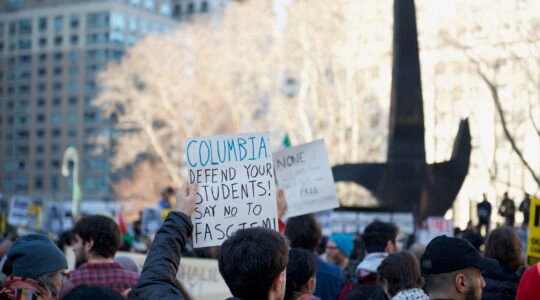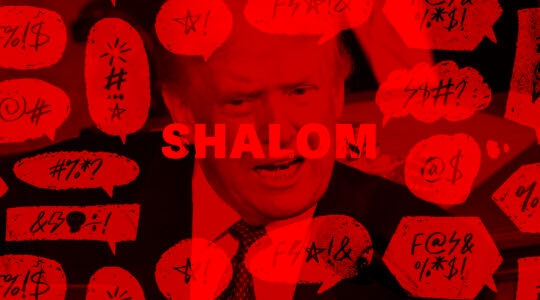
Gideon Taylor
NEW YORK (JTA) — A Swiss museum’s pledge this week to conduct a full search into the provenance of some 1,600 works of art it plans to accept from the estate of Cornelius Gurlitt, the son of one of Hitler’s main art dealers, once again has thrust the issue of Holocaust art restitution into the headlines.
The announcement by the Kunstmuseum Bern underscores the ongoing quest for the transparent restitution of Holocaust art, but we should remember that the problem is not Europe’s alone. Here in the United States, our own museums still have much to do.
A painting by Camille Pissarro, “Shepherdess Bringing in Sheep,” now sitting in a museum in Oklahoma after making its way from France more than half a century ago, illustrates the point.
The painting, originally owned by a French Jewish businessman, was seized by the Nazis in 1941 and trafficked through a Swiss art dealer known to have been a Nazi collaborator in art looting. Unbeknownst to the businessman’s family, the painting was brought to New York, where it was sold to an American couple in 1956. In 2000, the University of Oklahoma’s Fred Jones Jr. Museum of Art received the painting as a bequest from that couple.
The daughter of the original owners finally discovered the location of the painting in 2012. After the museum decided not to return the painting, the daughter began pursuing legal action to secure return of the painting. The museum has raised a series of technical defenses to deny the claim, including challenging the jurisdiction of a federal court in New York.
The World Jewish Restitution Organization has no involvement in the lawsuit and does not take positions in individual art cases. But we do advocate for museums to act ethically when pieces of art in their possession are alleged to have been looted during the Holocaust.
Unlike the approach the museum in Switzerland has announced it will take, the response from the governing body of U.S. museums has been most disappointing.
The American Alliance of Museums (AAM), the nationally recognized voice of the American museum community with almost 800 accredited museums, has declined to review the case. In response to requests for review, Ford W. Bell, the AAM chief, was quoted in various news reports as saying that the body’s accreditation commission would not review ethical compliance with AAM standards in cases “in which litigation is ongoing.” Bell added, “The accreditation commission is not a legal body.”
But the AAM’s own code of ethics stipulates clearly that the law should not be the determining factor in reviewing claims. “Acting ethically is different from acting lawfully,” the code says.
“Museums and those responsible for them must do more than avoid legal liability,” it says. “They must take affirmative steps to maintain their integrity so as to warrant public confidence. They must act not only legally but also ethically.”
Whether claimants exercise their legal rights in court is an entirely separate issue from whether the museum in question is acting, as the AAM puts it, “not only legally but also ethically.”
Museums are central to a civilized society. The American museum community, while understandably an advocate for artwork to remain in public hands, also has recognized that American art museum collections should not be tainted by art stolen during the Holocaust.
Thus in 2001 the AAM adopted the current version of the Standards Regarding the Unlawful Appropriation of Objects During the Nazi Era, following discussions with the Presidential Advisory Commission on Holocaust Assets in the United States, which was established by an act of Congress.
These standards, and the code of ethics for museums, are integral parts of AAM’s body of ethics, standards and best practices for museums. The standards stipulate that museums take steps to research the provenance of items of art in their collections and how to address claims.
It is difficult to follow the logic of an argument that would say that a determination of whether the museum is indeed meeting the ethical standards can be made only if a lawsuit has not been filed.
Either the standards are being met or they are not. Either the museum is acting ethically or it is not. The AAM cannot ignore its obligation to make that determination simply because a claimant is seeking to vindicate his or her legal rights.
Nor is the issue of a review by the AAM of a museum simply a theoretical one. Earlier this year, the AAM determined the Delaware Art Museum had violated the code of ethics by selling one of its paintings. The penalty imposed by the AAM in that case was not a light one: It removed the museum’s accredited status. Would the AAM have ignored this breach had there been ongoing litigation at the time?
The American public expects no less vigilant oversight of the museum community when it comes to claims relating to objects confiscated during the Holocaust. Regardless of whether and how claimants pursue their own individual claims, self-regulation by the American museum community must not translate into a failure to do what is necessary to ensure that the museum community’s own ethical standards are being met.
Gideon Taylor is the chairman of operations for the World Jewish Restitution Organization, which represents world Jewry in pursuing claims for the recovery of Jewish properties seized during the Holocaust in all countries except Germany and Austria.
JTA has documented Jewish history in real-time for over a century. Keep our journalism strong by joining us in supporting independent, award-winning reporting.






